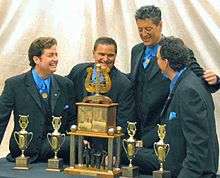Barbershop quartet

A barbershop quartet is a quartet of singers who sing music in the barbershop genre. It consists of a lead, the vocal part which generally carries the tune; a bass, the part which provides the bass line to the melody; a tenor, the part which harmonizes above the lead; and a baritone, the part that completes the chord. The baritone can sing either above or below the lead singer.
Quartets can be male or female, but are generally not mixed. A female barbershop quartet may be referred to as a Sweet Adelines quartet, and the vocal parts have the same labels, since the roles perform similar functions in the quartet even though the vocal ranges are different.
History
Barbershop singing originated in the late 1800s and early 1900s of America, a hybrid of both black and white expressive cultural forms at the time.[1] The African American influence is sometimes overlooked, although these quartets had a very formative role in the development of this style of singing.[2] Popularity of the style faded in the 1920s and was revived in the mid-20th century with help by the Society for Preservation and Encouragement of Barber Shop Quartet Singing in America, founded in 1938.[3] Some researchers view the style as an invented tradition based on the early musical features and the society's application of the barbershop chord with its contests and rules.[1][4][5][6]
Roles of vocal parts
Tenor
The tenor generally harmonizes above the lead, making the part the highest in the quartet. So as not to overpower the lead singer, who carries the tune, the part is often sung in falsetto, which is of a softer quality than singing in the modal register,[7] though some quartets do make use of tenors with a softer full voice quality.[8] Notable examples of barbershop quartets which made use of the full-voiced tenor include The Buffalo Bills and Boston Common.[9]
The range of a tenor in barbershop music does not necessarily closely correspond to that of a tenor's range in Classical repertoire, often being more in the range of the classical countertenor range.[10]
Lead
Lead usually sings the main melody.
Baritone
Baritone often completes the chord with a medium voice.
Bass
Bass always sings and harmonizes the lowest notes.
See also
- Gospel quartet
- Barbershop chorus
- Barbershop Harmony Society
- List of Barbershop Harmony Society quartet champions
References
- 1 2 Abbott, Lynn (1992). "'Play That Barber Shop Chord': A Case for the African-American Origin of Barbershop Harmony". American Music. University of Illinois Press. 10 (3): 289–325. doi:10.2307/3051597.
- ↑ Henry, James Earl (2000). The Origins of Barbershop Harmony: A Study of Barbershop's Links to Other African American Musics as Evidenced through Recordings and Arrangements of Early Black and White Quartets. Washington University.
- ↑ "History of the Barbershop Quartet, A Time-Honored Tradition". May 8, 2012. Retrieved July 23, 2012.
- ↑ Döhl, Frédéric (2014): From Harmonic Style to Genre. The Early History (1890s–1940s) of the Uniquely American Musical Term Barbershop. American Music 32, no. 2, 123–171.
- ↑ Averill, Gage (2003): Four Parts, No Waiting. A Social History of American Barbershop Harmony. New York: Oxford University Press.
- ↑ Garnett, Liz (2005): The British Barbershopper: A Study in Socio-musical Values. London: Ashgate.
- ↑ Hoch, Matthew (2014). A dictionary for the modern singer dictionaries for the modern musician. Lanham: Rowman & Littlefield Publishers. pp. 20–1. ISBN 0-8108-8656-1.
- ↑ editor, W.K. McNeil, (2005). Encyclopedia of American gospel music. Hoboken: Taylor and Francis. ISBN 1-135-37700-6.
- ↑ "Society Hall of Fame, Class of 2014". The Harmonizer. Nashville: Barbershop Harmony Society: 23. Winter 2014. Retrieved 12 May 2015.
- ↑ "Barbershop quartet singing". Encyclopaedia Britannica. Retrieved 12 May 2015.
External links
![]() Media related to Barbershop quartets at Wikimedia Commons
Media related to Barbershop quartets at Wikimedia Commons